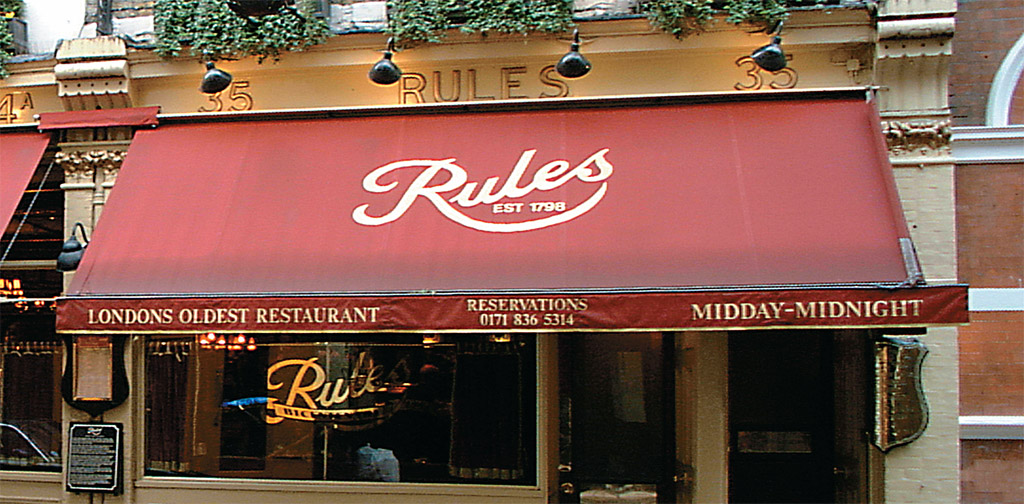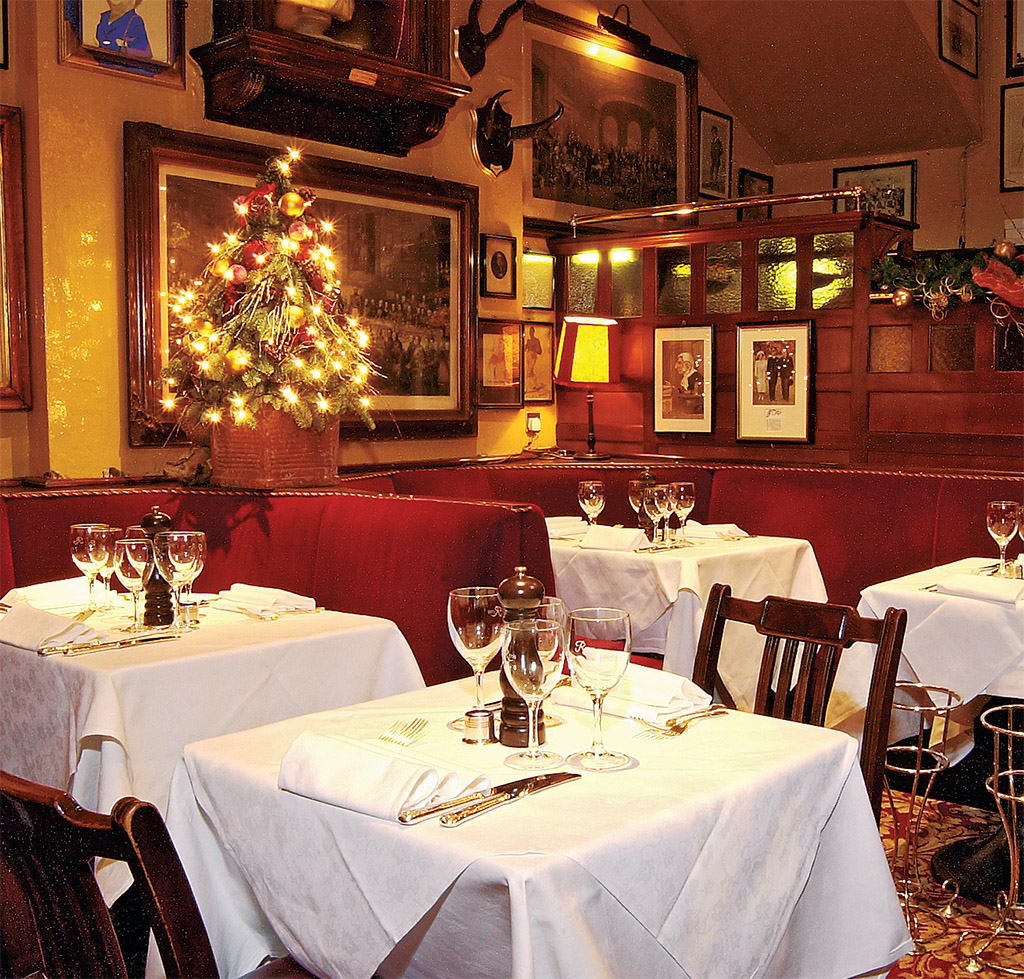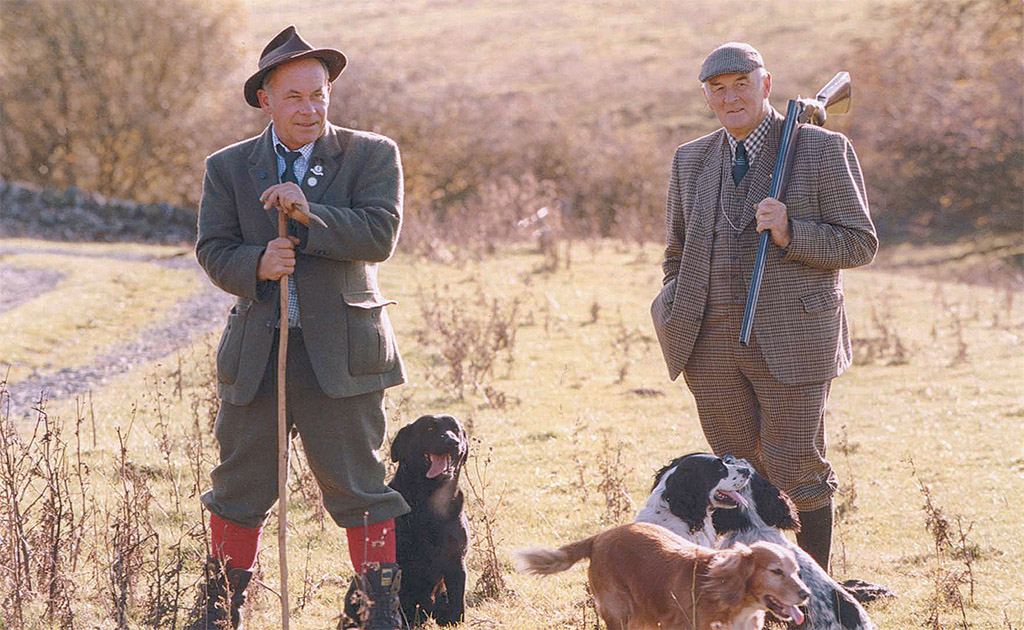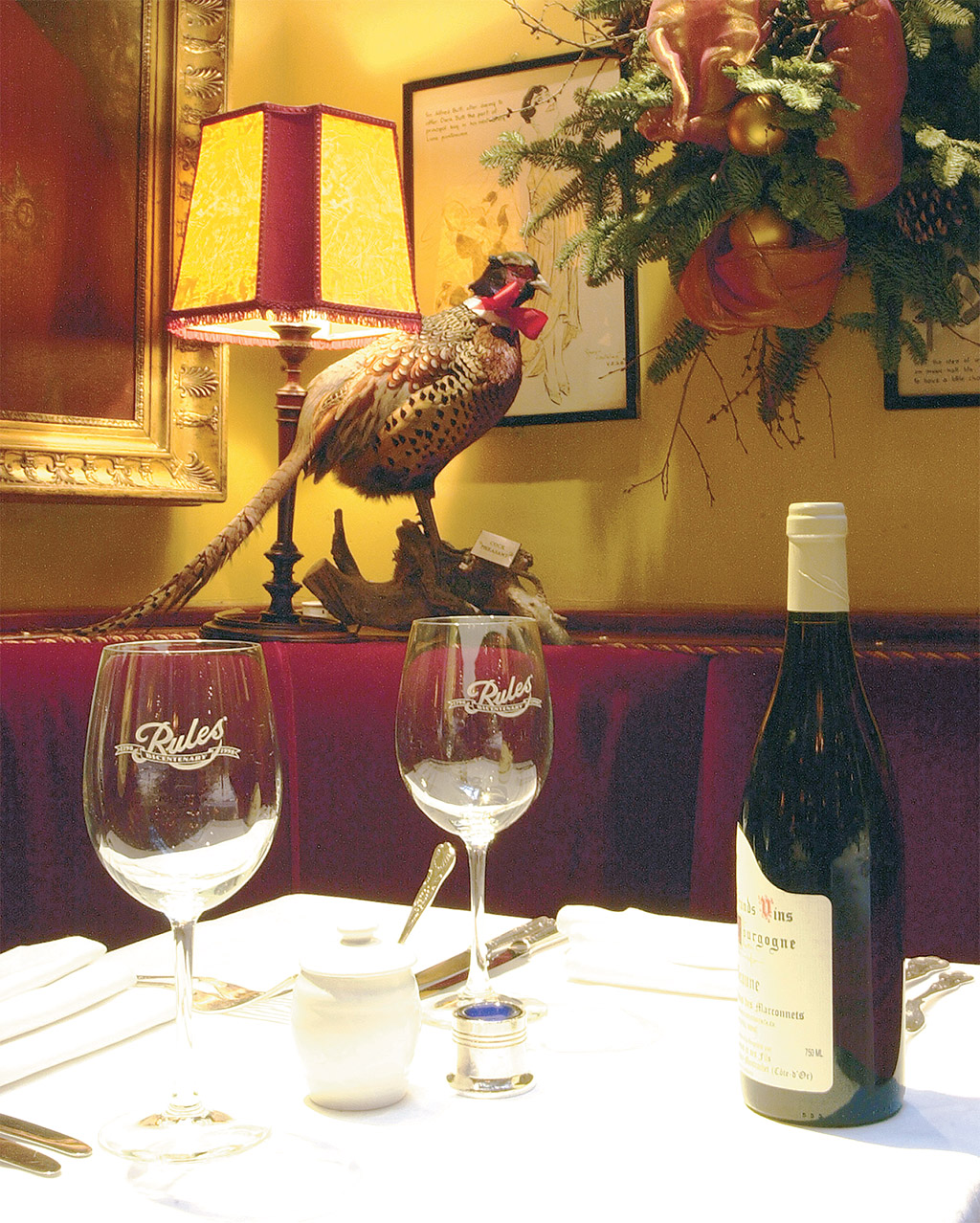
Rules: unique and irreplaceable
Many dancing dawns has this old beauty seen
Her elegant curves obscured by smokey age
But this painted lady remembers theatres dawn
And throws light upon all hands playing in linen fields.
[caption id="HistoricLondonDining_img1" align="aligncenter" width="1024"]

COURTESY OF RULES
SO READS A POEM INSCRIBED on a ceiling in Rules, the restaurant on Maiden Lane that calls itself London’s oldest. At least one may have been founded earlier, but none have stayed in the same spot for as long.
“We have records going back to 1798 when Napoleon was invading Egypt,” says Director Julian L. Payne. “What is nice is that it’s still in private ownership and has been owned by only three families. John Mayhew, the present owner, bought the business in 1984, and he comes from a history of restaurant owning. It is his only restaurant and will remain so.”
The restaurant’s founder was Thomas Rule, whose family became exasperated with his other business ventures—unspecified, but described as “lurid.” Promising to do better, Rule opened an oyster bar on Maiden Lane near Covent Garden.
“In 1798 Maiden Lane was a grimy, grotty part of town,” Payne says. “Just a block south of the Strand was a more dignified part, because it was near the river. Lords and ladies had homes there. The area north of the Strand was dirty and grubby, full of rakes and bandits.”
Grubby the neighborhood may have been, but the Thames teemed with oysters, and Thomas Rule proved to be a good entrepreneur. Originally the food of the poor, the oysters soon attracted upscale diners. A contemporary writer sang the praises of Rules’oyster bar and the “rakes, dandies and superior intelligences who comprise its clientele.”
Just before World War I, one of Rule’s descendants, Charles Rule, did a neat swap with a Brit named Tom Bell who owned a restaurant in Paris. The two exchanged businesses, although Bell left the running of Rules to a headwaiter called Charlie while he served as an officer in the Royal Flying Corps. John Mayhew bought Rules from Bell’s daughter in 1984.
[caption id="HistoricLondonDining_img2" align="aligncenter" width="1024"]

COURTESY OF RULES
[caption id="HistoricLondonDining_img3" align="aligncenter" width="1024"]

COURTESY OF RULES
Today’s clientele still includes intelligentsia, actors, politicians, writers, tourists and probably a few rakes and dandies. Rules is discrete about naming names, but a very young royal family looks down upon the lobby, Lady Margaret Thatcher appears in an irreverent mural and Noel Coward strikes attitudes in a private dining room.
“This is the heart of theater land, so this restaurant has always been theatrically driven,” says Payne. “People from all walks of life have been here and used this space, from Winston Churchill to the head of the FBI. We feed everybody on a level playing field. We don’t make a fuss about it, and that’s why they come here.” Probably the busiest restaurant in London, Rules serves more than 2,000 guests a week. A post-theater supper served there every month except December turns Rules into a “green room” for actors and theatergoers alike.
Starters at Rules might include Stilton and watercress soup, Cuan rock oysters, smoked Highland venison or foie gras terrine, followed by steak and kidney pie, grilled wild sea bass, wild Scottish salmon or new-season venison with white peaches. For afters, there is golden syrup sponge pudding with warm vanilla custard, cherry bakewell tart or white peach Bellini jelly with almond sponge and Cornish cream.
Some of this bounty comes from Lartington, Rules’own estate in the High Pennines. Known as England’s last true wilderness, Lartington provides roe deer, wild trout, salmon and some of the 18,000 game birds served each year. Lartington also serves as a base to teach Rules employees about game and gamekeeping. A neighboring farmer raises Belted Galloway, small cattle fed only on grass and hay with no chemical additives or feed concentrates. They produce remarkably good beef.
“This is one of the very few restaurants in London where you can get Belted Galloway,” says Payne. “We taste it in blind trials from time to time, and it’s certainly full of flavor. We think it’s delicious.” Surprisingly, all this bounty comes at reasonable prices.
“We have no dish on the menu more than £19.95. That’s our benchmark level that we don’t go above,” says Payne. “We still serve oysters, but we serve British food, too. Our menu changes four times a year. Our head chef, Dick Sawyer, classically trained at the Connaught, has an excellent feel for the type of food and the style of dishes people expect. We don’t set fashion here at Rules, we just continue to try to do better.”
Seemingly every inch of Rules’rich oak paneling is covered with art. Caricatures of military men, fops, fishin’ and shootin’ types, actors and probably a few rakes and rascals line the upper walls. A pair of Moors hold torchiers, dried hops frame a mirror and old documents dangle wax seals. There are paintings, prints, game heads, stuffed birds, oils and watercolors everywhere. Once hung, the art stays in place.
“We add something occasionally if we can find a nook or cranny for it,” Payne says. “We are full of interesting bits of memorabilia, some old, some new, some borrowed, some blue. It represents mainly Victorian and Edwardian style.” There is a clock in every room, along with red-shaded, fringed lamps, and gas fires burn in the cold months.
[caption id="HistoricLondonDining_img4" align="aligncenter" width="1024"]

With all this history, tradition and splendor, it seems almost unthinkable that in 1971 the Greater London Council proposed to widen Maiden Lane and knock down Rules. Poet John Betjeman rose at a planning enquiry to make an impassioned plea against this proposal, calling Rules’interior “unique and irreplaceable, and part of literary and theatrical London.” Partly due to his efforts, Rules still stands, and one of the four private upstairs dining rooms is named in Betjeman’s honor. It is paneled with oak from a tree that fell down on the Lartington estate, and it seats up to 10 guests.
Another room, which seats up to 12, is named for Charles Dickens, who haunted Maiden Lane as a boy, probably tantalized by the delicious odors emanating from Rules. A glass cabinet in this room holds bottles of House of Parliament whisky signed by Margaret Thatcher’s cabinet from 1990. “One of our more inebriated guests broke the glass one day and took a bottle, but now we have one signed by Tony Blair,” says Payne.
The Graham Greene Room features a case of miniature liquor bottles actually belonging to Greene that were featured in the 1959 movie Our Man in Havana. “Graham Greene dined here, and he wrote us into several books and said wonderful things about us,” says Payne.
Lastly is perhaps the most famous private room, where Edward VII wined and dined Lillie Langtry. Pictures of the king, looking very well fed, and the glamorous actress line one wall. Today the room which once had the most celebrated “table for two” in London, is popular for family gatherings, corporate parties and the like.
Summing up Rules’continuing appeal, Payne says: “We are all here because we like the association with the man who owns it and with the building. It becomes slightly addictive, and we want to look after it. It will be here tomorrow, and we’re all just curators. We want to pass it on in better shape than that [in] which we found it.”





Comments